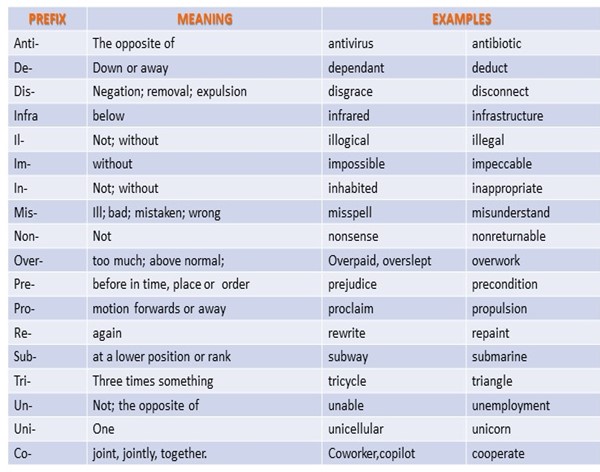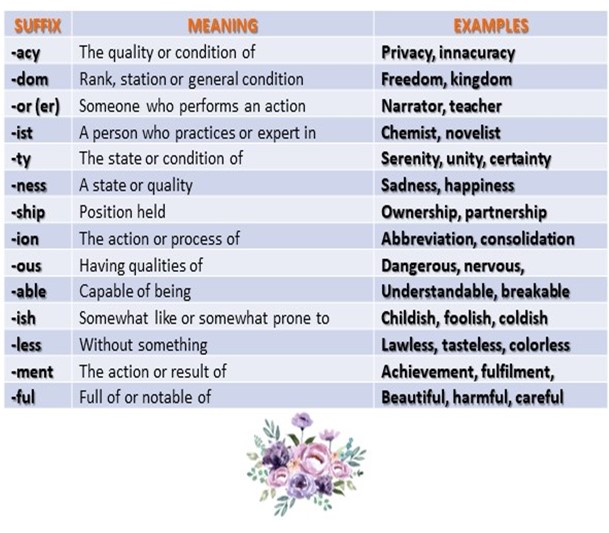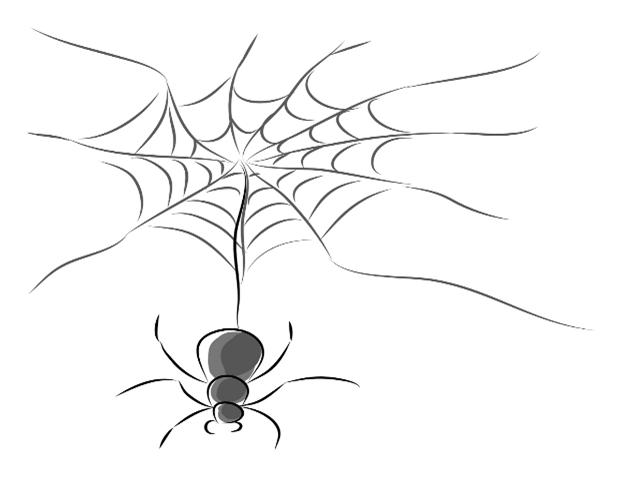I. WHAT IS A PREFIX?

A prefix is a group of letters that is placed before the root or stem of a word. For example:
- happy – unhappy
- national – multinational
- load-upload
When we use prefixes we usually change the meaning of the rooted word.
- honest=someone who is sincere.
- dishonest=someone who cheats.
Here are some examples of prefixes and their meaning:

II. WHAT IS A SUFFIX?
On the other hand, a suffix is a letter or a group of letters that is placed after the root or stem of a word. Suffixes help to make up new words or to change the grammatical function of a word.
- read = verb ………………….reader = noun
Here are some examples of suffixes and their meaning:

III. CONSOLIDATION I.
IV. CONSOLIDATION II.
V. EXERCISE I.
VI. READING TEXT.
READING COMPREHENSION AND VOCABULARY BUILDING

ARACHNOPHOBIA
When a fear of spiders becomes a phobia (arachnophobia), it consumes your thoughts, interferes with your daily activities and keeps you from socializing with your family and friends. Well, I have a friend who is awfully afraid of spiders, which is not quite unusual. I admit I don't really like spiders much myself. I don't mind them if I see them outside in the garden. But if one comes in the house, I get terrified, especially if it's one of those really big spiders with furry legs; then I try to get rid of it immediately.
This is quite normal, I think. But my friend isn't afraid of spiders in any normal way. She is totally, completely and utterly terrified of them. When she sees a spider, she screams as loud as she possibly can. She runs away or asks someone else to get rid of the horrible creepy-crawly, while crying. She screams so loud that we worry about her and think about calling the police. When she sees a spider, she shivers all over and sometimes she can't move at all because she is so terrified. Sometimes she starts sweating or shaking. There is tightness in her chest and rapid heartbeat. Many times she has even fainted.
But my friend had a surprise for me when we met for coffee last week.
'Guess what?' she asked me. 'What?' I said. 'I've got a new pet!' 'Great,' I said. 'What is it? A dog? A cat?'.
My friend looked at me happily and said, ´I got a dark spider! ´. She continued when she saw my eyes open like big dishes. 'It's true! I decided that it was time I did something about my phobia, so I went to visit a doctor, a special doctor. A psychiatrist. This psychiatrist specializes in phobias – helping people who have irrational fears to get better and live normally. He told me I suffered from "arachnophobia".
Then, she explained how the doctor was going to try to cure her phobia and went slowly step by step following a "behavioral approach”, which is a method to make her overcome her fears little by little. First, she had to be able to see a non-real spider. When she could be watching the spider for a few minutes the doctor said that they were going to continue working in the same way for some days. The doctor asked her to go back the following day.
My friend went back the next day, and this time she touched the spider and held it for five minutes. Then the doctor told her to go home and come back the next day. The next day she went back and the plastic spider was on her chair. She had to move the spider so she could sit down. The next day she held the spider in her hand while she sat in her chair. The next day, the doctor gave her the plastic spider and told her to take it home with her. My friend refused to but the doctor insisted on. Finally, she took it and said to herself, “it is just a plastic spider”.
She could manage having the spider at home for some days following the directions that the doctor asked her to do.
'So now I've got a pet spider!' she concluded.
'Well done!' I said.
'There's only one problem,' she said, and as she spoke, I noticed that she was shivering all over. Then she screamed and climbed up on the chair. She was pointing to something on the floor.
'Over there!' she screamed. 'Look! It's a beetle!'
VII. PRACTICE I.
VIII. PRACTICE II.
IX. BIBLIOGRAPHY
Azar, B. S. (2003). Fundamentals of English grammar. Longman.
Carter, R., & McCarthy, M. (2006). Cambridge grammar of English: a comprehensive guide; spoken and written English grammar and usage. Ernst Klett Sprachen.
Mares, G. (2020). How to use adjectives – video. Oxford Online English. https://www.oxfordonlineenglish.com/how-to-use- adjectives.
Murphy, R. (2019). English Grammar in Use. Fifth Ed. Cambridge.
Murray, L. (2014) English Grammar. Cambridge University Press.
X. WEB RESOURCES
Images_Compra propia de licencias de banco de imágenes de Pixton y Pngtree, exentas de derechos de autor. https://www-es.pixton.com/ & https://es.pngtree.com/free-backgrounds.
Reading Text retrieved and adapted from https://learnenglish.britishcouncil.org/general-english/story-zone/b2-c1-stories/a-seriouscase?fbclid=IwAR1Qhxr0Q6RwKvNjSTXIfFVuWJUkjZ8rPJybIEGqqxyg8eqsbfgyz-DqoCQ
XI. CREDITS
- All practice exercises and charts were written by Shareni Murillo Granados_2022_ENES- LEÓN-UNAM
- Audio version performed by Kimberly, Isabella, John and Matt_Compra propia de licencia de uso de voces en Voicemaker, exenta de derechos de autor. https://voicemaker.in/ _Connie Reyes Cruz_2022_